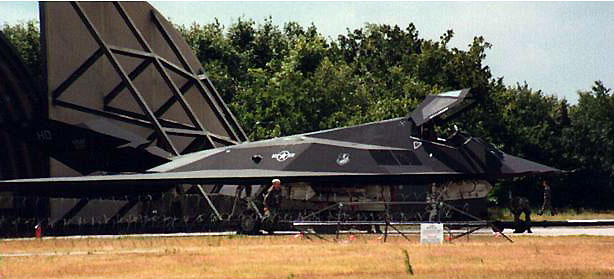
The Lockheed F-117A Night Hawk is a single-seat, wedge-shaped, V-tailed low observable night attack fighter with the technology to reduce its vulnerability to radar detection (stealth). One of the most important things to get stealth is RAM Radar-Absorbent-Material. The basic principle behind RAM coating is this: the coating contains carbonyl iron ferrite (special paint using this material is known as “iron ball’ paint). When a radar wave encounters this coating, it creates a magnetic field within the metallic elements of the coating. The field has alternating polarity and dissipates the energy of a radar signal.
Constructed primarily of aluminum, the F-117A’s fuselage comprises flat panels known as facets mounted on the aircraft’s subframe, their purpose being to reflect radar energy away from the transmitter itself, thus denying the operators a visible ‘return’. All surfaces are coated with various radar absorbent materials. All doors and panels have serrated edges to further minimize radar reflection. Grid covers on the intakes and the use of narrow-slot ‘platypus’ exhausts surrounded by heat-absorbing tiles further reduce the chances of IR detection. Ahead of the flat-plate five-piece cockpit glazing is a FLIR sensor, recessed in a mesh-covered housing; in the forward starboard underfuselage there is a retractable DLIR and laser designator. These sensors are used in conjunction with LGBs, two of which can be carried in the double-section weapons bay.
The F-117A is not intended for air-to-air combat, its purpose to deliver ordnance (precision-guided bombs) in a dense threat environment against targets of extremely high value.
During 1975, Lockheed’s Skunk Work engineers began working on an aircraft which would have a greatly reduced radar cross section that would make it all but invisible to enemy radars. This was the beginning of the project Have Blue.
Have Blue were two 60-percent scale flyable test aircraft. The first aircraft was intended to evaluate the type’s flying characteristics, the second was to evaluate the radar signature. Lockheed did give the aircraft its own manufacturer’s serial numbers ..-1001 en ..-1002, meaning Plant 10, aircraft numbers 1 and 2.
The first flight of the Have Blue took place in January or February 1978 (the exact date is classified) from Groom Lake Test Facility in Nevada in high secrecy. On May 4, 1978, Have Blue prototype number 1001 was landing after a routine test flight when it hits the ground very hard, jamming the right main landing gear in a semi-retracted position. Pilot Bill Park pulled the aircraft back in the air, and repeatedly tried to shake the gear back down again. After his third attempt failed, the pilot was ordered to eject. The Have Blue aircraft was destroyed in the crash.
Have Blue 1002 arrived at Groom Lake shortly after the loss of number 1001. It took the air for the first time in June of 1978. During its 52nd flight one of the J85 engines caught fire. The fire was so intense that the hydraulic fluid lines were burned through. The pilot was forced to eject, and the 1002 was a total loss.
The F-117A had the same general configuration of the Have Blue test aircraft, but was much larger and heavier and was provided with an offensive military capability. Lockheed used F-16 flight control computers, F-18 cockpit displays and C-130 environmental systems. The first flight was on June 18, 1981. Lockheed test-pilot Harold C Farley made a successful first flight in number 780. The 59th and last Night Hawk was delivered on July 12, 1990.
F-117A Night Hawk in combat:
Operation Just Cause: December 20th 1989 :
The F-117A first saw action in December 1989 during Operation Just Cause in Panama. Six F-117As flew non-stop from Tonopah Nevada with air refueling to attack the Rio Hato barracks in Panama, two of them dropped GBU-27 bombs and missed the target.
Desert Storm January 17th – February 28th 1991:
The Gulf War effectively began when an F-117A bombed an air-defense control center in Baghdad. A USAF after-action report found that Iraqi forces could not detect the F-117A approaching and often would not start shooting until the bombs exploded. During operation Desert Storm , the F-117A enabled it to fly 1.271 combat sorties in 42 days without losses. Although only 36 stealth fighters were deployed in Desert Storm and accounted for 2.5 percent of the total force of 1,900 fighters and bombers, they flew more than a third of the bombing runs on the first day of the war. In all during Desert Storm, the stealth fighter conducted 1.271 sorties, dropped more than 2,000 tons of bombs, and flew more than 6,900 hours.
Allied Force: March 24th – June 10th 1999:
During UN operation ALLIED FORCE, both the 8th FS and 9th FS deployed to Europe. This combined unit was nicknamed the “789th” “Screamin Sheep in the Knight”.
There were 25 F-117A’s deployed to Europe (12 to Italy, Aviano AB and 13 to Germany, Spangdahlem). One F-117A (82-0806/HO) was shot down (March 28) by a SA-6 missile in Serbian near by Budjanovci. The pilot was ejected safely, a Combat Search and Rescue-team of the USAF brought the pilot back by his squadron (7th FS). F-117A’s flew combat missions against the most highly defended, high value targets throughout the 78-day air campaign, including first-night attacks.
Iraqi Freedom March 20th – April 9th 2003:
On the first night of the attacks in Iraq two Air Force Lockheed F-117A’s dropped precision-guided, 2,000-pound JDAM (Joint Direct Attack Munition) on intelligence service headquarters and a Republican Guard facility in Baghdad, intelligence sources believed Saddam Hussein and other top regime leaders were staying there. The Night Hawks flew from Al Udeid AB in Qatar.
Retired
The F-117 was retired during ceremonies at Palmdale and Tonopah on April 22, 2008. Four aircraft were kept flying beyond April by the 410th Flight Test Squadron at Palmdale for flight test. By the beginning of August, two were remaining, and the last F-117 left Palmdale to fly to Tonopah on August 11, 2008. With the last aircraft leaving for retirement, the 410th was inactivated in a ceremony on August 1 2008.
| Developing Nation: | United States of America. |
| Manufacturer/Designer: | Lockheed Skunk Work. |
| Task: | Precision attacks against high-value targets. |
| First Flight: | April 20, 1982 80-0785. |
| First Delivery: | August 1982. |
| First Operational: | October 1983. |
| Crew: | 1. |
| Ejection Seat: | McDonnell Douglas ACES II zero-zero. |
| Wing Span: | 13,20 m. |
| Wing Area: | 105.9 m². |
| Length: | 20.08 m. |
| Height: | 3,78 m. |
| Engine (s): | Two General Electric F404-GE-F1D2 non-afterburning turbofans each rated with 48.04 kN. |
| Weight: | – Empty: 13.608 Kg. – Max. payload: 2.268 Kg. |
| Max. Take off weight weight: | Max. take off: 23.814 Kg. |
| Cruise Speed: | 933 km/h. |
| Max. Speed: | 1.074 km/h at m. |
| Max. Range: | 1.112 km. |
| g limits: | + 6 |
| Radar: | none. |
| Centreline hardpoint(‘s): | The two weapon bays are equipped with a trapeze for the carriage of bombs up to 907 kg. |
| Weapons: | – AIM-9 Sidewinder. – AGM-65 Maverick. – AGM-88 HARM anti-radiation missiles. – BLU-109 deep-penetration bombs. – GBU-10 Paveway II. – GBU-27 Paveway III. – Joint Direct Attack Munitions. – TALD (air-launched decoy) |
| Extra: | RAM Radar-Absorbent-Material. |
Lockheed F-117A Night Hawk crashes:Aircraft number 80-0785 was ready for his first flight on April 20,1982 unbeknownst to anyone, the fly-by-wire system had been hooked up incorrectly (pitch was yaw and visa versa) and the plane crashed. On July 11,1986, Major Ross E.Mulhare (aircraft number 80-0792) flew into a mountain near Bakersfield, California the cause of the crash has never been officially revealed, but fatigue and disorientation during night flying has been identified as a probable cause. Major Ross E.Mulhare died in the crash. On October 14,1987 Major Michael C Stewart crashed (F-117A number 85-0815) in the Nellis range just east of Tonopah, Nevada, disorientation en fatigue are the problem of these crashes. Major Michael C Stewart died in the crash. F-117A 82-0801 crashed August 4, 1992 near La Luz, New Mexico, pilot ejected safely. An Air Force F-117A Nighthawk (86-0822) from the 49th Fighter Wing, Holloman AFB, N.M., crashed 7 miles south of Zuni, New Mexico, May 10, 1995. The pilot, Capt. Kenneth W. Levens, 9th Fighter Squadron, was killed in the crash. The stealth was on a training mission when the accident occurred. 81-10793 an Air Force F-117A Nighthawk crashed September 14, 1997 while performing a fly-by demonstration for an airshow at Martin State Airport, 12 miles northeast of Baltimore. The pilot, Maj. Bryan Knight, safely ejected. He suffered minor injuries. Four people on the ground were injured and 10 families displaced by the crash, which caused extensive fire damage to several homes and vehicles. There were no fatalities or serious injuries. F-117A (82-0806/HO) was shot down (March 27, 1999) by a SA-6 missile in Serbian near by Budjanovci. The pilot was ejected safely, a Combat Search and Rescue-team of the USAF brought the pilot back by his squadron. |

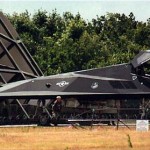

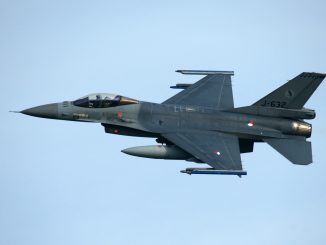
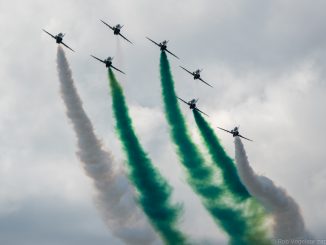
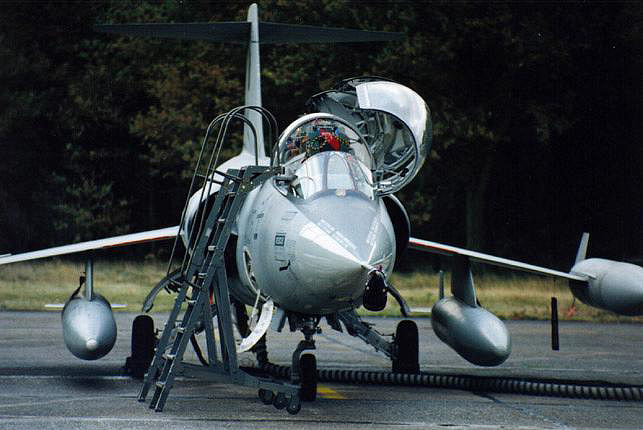
Be the first to comment